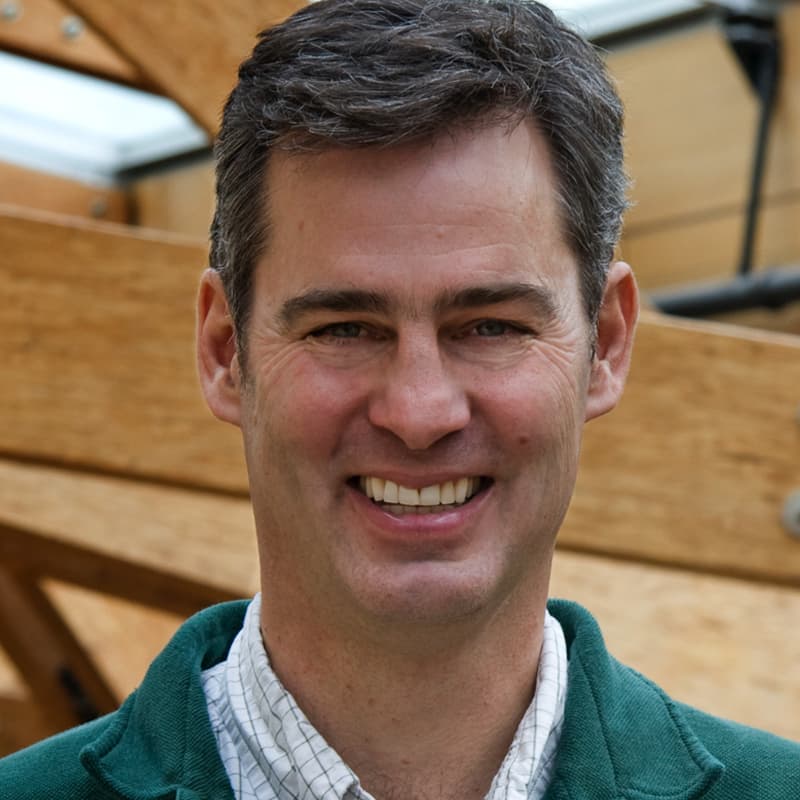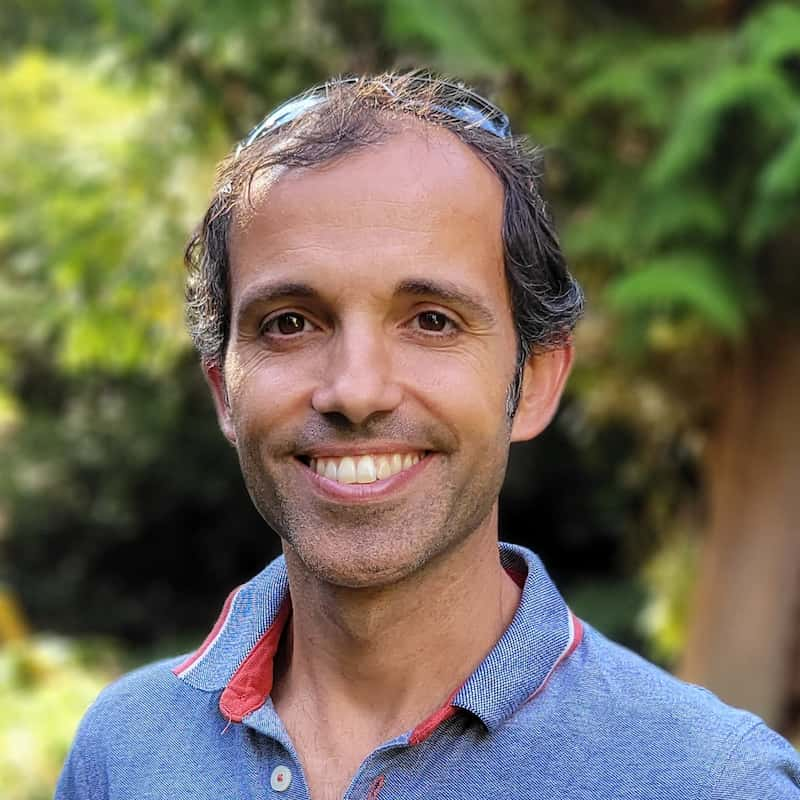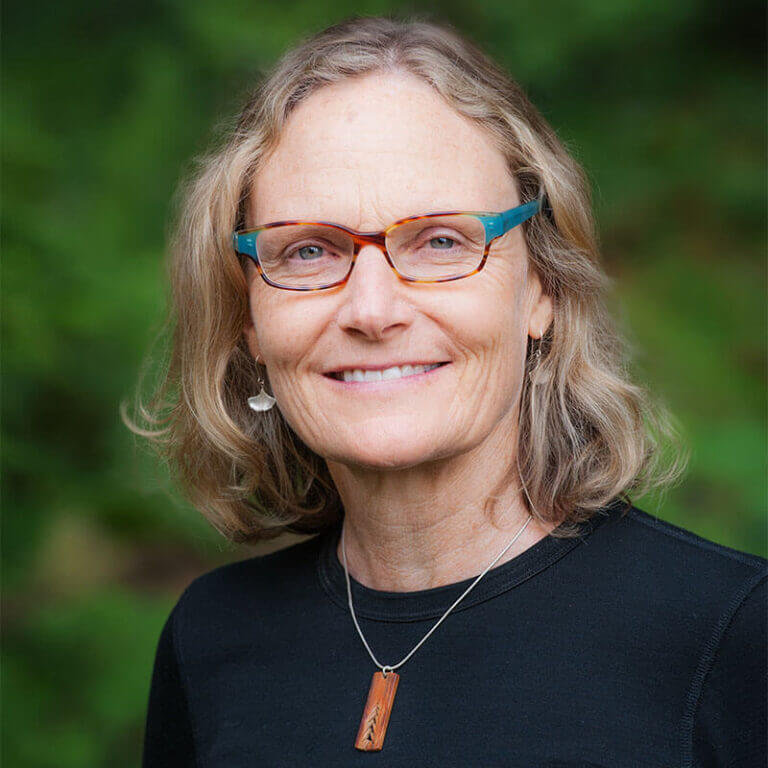
Diversification could be a boon for ecosystems and the economy
A student uses the TimberOps virtual reality tool at the UBC Forestry & Environmental Stewardship Action Lab. The technology combines spatial data into a single visual map to help with operational planning and consultation
In this age of the Anthropocene, the pressures of human activity are impacting everything from fish populations to weather patterns, compelling dramatic shifts in climate and ecosystems that parallel some of antiquity’s most Earth-altering natural disasters.

“The global forest sector has become so challenged by climate change and extreme weather events,” UBC Forestry & Environmental Stewardship Assoc. Prof. Dominik Roeser comments from Northern Italy in July 2022, as a record-breaking heatwave seared much of Europe and alighted deadly wildfires.
Growing up and studying in Germany, Dominik saw how that country has tried to find a balance between the needs of the forestry sector and ecologic and human values. Continuous cover silviculture systems, which promote uneven-aged woodlands as opposed to even-aged plantations, were practised to some extent there – as well as in parts of Switzerland, France, Austria and Slovenia – since the late 1800s, according to a 2004 historical review. Today, the practice is one of many sustainable forest management tools applied by foresters, as well as landowners.
Sustainable forest management is defined by the Food and Agriculture Organization of the United Nations as the stewardship of forests to maintain their biodiversity, productivity, regenerative capacity, vitality and long-term ecological, economic and social functions. This can take the form of managing species diversity and age; public and private partnerships to control pests and fire risk; providing corridors for species movement; removing invasive species; and planting species better adapted to changing environmental conditions, according to a 2016 sustainable forestry article.
In British Columbia, Indigenous peoples have lived in harmony with forests for millennia, establishing knowledge and traditional practices derived from hands-on experimentation and cultivation of forest ecosystems. Increasingly recognized for the important role they can play in present-day sustainable forest management, Indigenous approaches are the focus of scholarship and education at more and more institutions, such as UBC, and are being integrated to a greater extent into industry best practices and government policies.
“Indigenous peoples were long-time stewards of the land; and, now industry, academics and government are considering that in terms of helping with designing sustainable forestry frameworks and research questions,” says UBC Forestry & Environmental Stewardship Asst. Prof. Danielle Ignace. “It has to be done in a respectful way, but I think we’re at a place to do that.”
Diverse perspectives
Danielle researches the connection between organisms, including humans, and their environment in her field of ecophysiology. A lot of her work now focuses on different ways of knowing.
She often finds herself asking how forestry can bring to the table the voices and perspectives of more disparate communities to identify potential inroads and novel approaches to tackle the climate challenge: “How can we be more inclusive, diverse and sustainable at the same time?”
Answering this question could give voice to the views and knowledge of people from often underrepresented communities, cultures and ethnicities.

“Scientists once worked in a bubble, without a lot of community engagement or concern for the harms and pollution inflicted on the natural environment and human populations,” notes Danielle, who is an enrolled member of the Coeur d’Alene (Schitsu’umsh) tribe from Idaho, US. “Now we are adding that community component to realize a more holistic approach.”
Including diverse perspectives is particularly important when implementing new policies and for decision-making within forestry and other areas of science, technology, engineering and math, aka STEM, she says.
The status quo is increasingly untenable in a political, social, ecological and commercial landscape that must address sometimes diametrically opposed needs when it comes to recreation opportunities in forests, eco-tourism, species migration routes, protection of old growth trees and fish habitats, as well as mitigation measures for wildfires and floods.
Diversifying forest management in BC is a long time coming, remarks Dominik, and something that must be realized sooner rather than later.
“We’ve moved from a narrow focus driven by economics to a more holistic approach that takes into account more diverse landscape values,” he adds. “This involves selecting tailored solutions that work best to achieve multiple values on the landscape and that are driven by changing societal and environmental conditions.”
The need for local engagement
According to Natural Resources Canada, the forestry sector contributed $25.2 billion to the Canadian economy in 2020. That same year, Government of BC figures indicate that forestry contributed $1.27 billion to provincial coffers.

“Forestry has generated enormous amounts of wealth and has the potential to keep doing so,” says UBC Forestry & Environmental Stewardship Assoc. Prof. Harry Nelson. “However, this has come at a cost in terms
of biodiversity, the aesthetic value of forests, hydrology and other externalities.”
Competition among forestry companies has also historically perpetuated some unsustainable practices in the BC marketplace, notes Harry, who adds that “the volume-based system has not served us well.”
Harry describes a hypothetical scenario in which one out of 20 valleys is harvested. “Harvesting only one valley isn’t enough to cause widespread impacts on species, habitats, streams and watersheds. But, by the time you get to the 18th or 19th valley, the cost to the system has changed.”
Society is taking note, Harry remarks: “this is reflected in such things as how polarized the debate around harvesting old-growth trees has become.”
Instead of allowing several companies to log a certain number of trees from one area, i.e., a volume-based system, Harry believes an area-based system could yield a more sustainable result. In area-based systems, each company is allocated a parcel of land that only it can log to a given threshold. This, Harry believes, could change the mindset from one of ‘how can we most economically get better logs from here than other companies?’ to ‘how can we retain the value of this land over the long term?’ Additional government oversight and community engagement can also play an important role in managing forest resources optimally and sustainably, he adds.
Many groups, including Indigenous groups, have been fighting for a long time to have our different knowledge systems, ways of knowing, voices and perspectives heard, valued and supported.
“We want to retain healthy biodiversity, fish habitats, Indigenous reconciliation and a robust industry, but right now the lines of engagement are either too complex to be meaningful or not yet in place.”
The Government of BC’s Forest Landscape Plans process is trying to address this by engaging communities, including Indigenous communities, in conversations surrounding how to manage forest resources. Following updates to BC’s forest management regime, such as the Forest and Range Practices Act, the new plans will eventually replace the former Forest Stewardship Plans.
“I believe that we need to shift a lot more of the responsibility for forest management decision-making back to the local level, which would include local communities and Indigenous groups,” says Harry.
“At the end of the day, more local management and community forests could effectively allow for more tailoring to meet local conditions and values. Forest management systems could ultimately generate more accountability and responsibility, taking into account a wider range of values, or values that are matched by investment in the sector and a longer-term perspective.”
Challenges ahead
Forests have evolved for around 400 million years, adapting through ice ages, mass extinctions and assorted pests and diseases. Since humans began to live among them, trees have provided us with shelter, sustenance and materials for our tools and lodgings. However, a myriad of human-caused stressors and placing increased pressure on forested ecosystems.

The 2021 heat dome scorched areas in the southeast of BC with above 40-degree-Celcius temperatures. In its wake, UBC Forestry & Environmental Stewardship Asst. Prof. David Montwé saw many of the ponderosa pine, Douglas-fir, western larch and other seedlings that Ministry of Forests researcher Deb MacKillop planted the year before stunted or die. Of the lot, ponderosa pine seemed to fare the best: “although it’s still hard to say to what extent before we do the number crunching,” David admits.
Together with the Ministry of Forests in Golden, BC, David is researching new approaches to forest management that will likely be needed to adapt to climate change and the severe weather it heralds.
He sees hope in silviculture approaches such as the shelterwood system, in which the forest canopy is removed gradually over many years to provide seedlings with shelter from the sun’s radiating heat. The approach can also slow or stop a fire by forcing it to leap further to alight neighbouring branches.
Another approach to reducing the impacts of heat and drought is thinning. Curtailing competition for resources, such as water, nutrients in the soil and sunlight, can give individual trees more leeway to focus their energies on growth, he says. It’s a process that comes at the cost of efficiency, and one that will require new harvester technology and technician training to hit the ground running, he admits, but one that may be necessary to improve forest resilience.
Next-generation products and services
Since the dawn of human civilization, global forests have declined by around 46%, according to a 2015 global forest survey published in Nature. A 2020 Food and Agriculture Organization of the United States report highlights that, only three decades ago, global forests were estimated to be 420 million hectares larger than they are today.
While deforestation has slowed, there remain questions about how to manage a resource that takes several decades to replenish and is now largely second-growth.
In the BC context, products produced from wood may need to get with the times, says Dominik.
“Right now, we make the most money from sawn logs. Moving forward, we need to look for more high-value products, such as mass timber, bioproducts, textiles, perfumes and other extractives, to broaden our product base.”
“We need to find very high-value products from wood to take more pressure off of traditional forestry products — such as large, old-growth stands — which are not as easy to source as they once were.”
The shift is already happening, Dominik says. “In other parts of the world, a pulp mill is now called a biorefinery. They still make pulp and paper, but they’re also making some more advanced bioproducts out of lignin and other extractives from wood.”
The overall industry diversification picture should also include high-value forest services, such as carbon sequestration, clean water, biodiversity services, recreational opportunities and cultural values, Dominik adds.

Carbon capture and multiple other forest services occupy a great deal of UBC Forestry & Environmental Stewardship Asst. Prof. Ignacio Barbeito’s headspace. “With every forest management practice we select, there are trade-offs to consider that will impact other systems, such as carbon capture stored in trees and soils, along with biodiversity,” says Ignacio.
“For example, certain silvicultural systems can prolong tree regeneration, thus increasing biodiversity. However, this can also increase the odds that the forest could be negatively impacted by fire or pests within a 140-year versus a 120-year growth cycle.”
Ignacio researches the costs and benefits of different forest regeneration approaches. His work is hands-on and data-driven. He takes countless measurements of tree girth and height. He collects core samples by cutting through tree rings using an incremental borer. And he sifts through stacks of data collected by the Government of BC over the years.
“BC has a wealth of long-term experiments from the 1970s, ’80s and ’90s that can help us address many questions by looking back and also not having to start from scratch,” Ignacio says. “When it comes to forest regeneration investigations, the problem is that it can take many years before we can reach a solid conclusion.”
For example, sifting through past studies, Ignacio was able to see that the pine weevil did not use to be a problem at high elevations in BC. However, “now we are seeing it damaging trees 1,500 metres and above close to Vernon,” he shares.
Ignacio’s research is also helping to fill in blanks surrounding wood quality, as well as how mixed forests can improve forest resilience; interactions between broadleaf and conifer forests can impact their growth and yield, and different harvesting practices can impact all of the above.
“Conifers mixed with deciduous species tend to fare better in drier climates and be less prone to the effects of fire,” he notes. “There is a lot of potential to, for example, increase the value of our deciduous forests as a wood product.”
Almost all commercial timber currently harvested in BC is coniferous. Adding more broadleaf trees to the mix could loosen some of the demand for conifers while concomitantly diversifying the market and potentially aligning it with research that supports planting a variety of trees.
“The point here is to not put all your eggs in one basket,” says Ignacio. “We need to start looking at wood quality as opposed to volume, particularly as we are harvesting mostly second-growth forest now.”
Science and technology
Natural resources, such as forests, are under increased pressure from the encroachment of human populations and extreme weather from climate change that is leading to more
drought, fire activity and flooding. As the stressors mount, many forests in the Pacific Northwest have become more prone to die-off from disease and infestations, such as the mountain pine beetle and spruce budworm.

“We’re trying to hit a moving target,” says UBC Prof. Sally Aitken. “Trees we plant now will be facing hotter temperatures when they’re older, so we need to consider that when selecting seedlings.”
Sally and her team at the Centre for Forest Conservation Genetics and the Genome Canada-supported, applied genomics CoAdapTree research project look for genetic characteristics to discover the seed source with the greatest potential to be well-adapted to a region. Examples of this include identifying trees that are more drought-tolerant or have the ability to thrive in cooler temperatures as seedlings and warmer temperatures as mature trees.
Her work involves DNA sequencing using massively powerful computers that sift through tens of thousands of genes from different tree species.
“Long-term field experiments can take 10 to 20 years to understand the population differences and what aspects of climate could affect their survival,” notes Sally. “So far, we have been getting similar results from our genomic methods as others have from these long-term field experiments, but in a fraction of the time.” Once the right mix of seedlings is identified, ‘assisted migration’ is used to transport seedlings to areas where they’re better suited to the climate – and future climate projections – within or outside of their naturally occurring ranges.
In BC, this could look like planting western larch outside of its range or planting a species of Douglas-fir found in a slightly drier or warmer environment within a Douglas-fir range, Sally explains.
Models and big data
Technology has become essential to much of the data collection undertaken by researchers at UBC Forestry & Environmental Stewardship. Advances in remote sensing, software, web applications, as well as big data and number crunching seem to have become the norm rather than the exception.

UBC Assoc. Prof. Tongli Wang’s climate and ecological modelling applications provide a glimpse into the future. Tongli’s scale-free climate models downscale the currently available gridded climate data to specific-point locations through a dynamic local downscaling algorithm, providing more accurate climate data.
His models integrate historical and future climate data into the same package, and cover BC (climatebc.ca) and other parts of North America (climatena.ca), along with the Asia Pacific (web.climateap.net). With over 2,500 subscribers, Tongli’s applications have served as important tools for climate change-related studies and applied work, particularly in the development of ecological models.
“There is a mismatch between the climate that trees have adapted to and the climate that they will face in the coming years,” says Tongli. “This mismatch can cause problems for trees in the future. To help deal with this, scale-free, climate data-based ecological models can project the range of suitable climate conditions in which trees can survive and grow given different climate scenarios.”

Tongli and his team work on projections that range from forest ecosystems to individual tree species and tree populations. Their scale-free climate models also help UBC Forestry & Environmental Stewardship researchers, such as Canada Research Chair in Remote Sensing Prof. Nicholas Coops.
The Integrated Remote Sensing Studio Nicholas heads is at the leading edge of technological innovations that are pushing the boundaries of possibility. At the fingertips of Nicholas and his team is everything from drones to satellites, LiDAR, aeroplanes and mobile phones. These high-tech tools collect data on forest structure and dynamics; biodiversity; carbon accumulation; leaf chemistry characteristics; as well as the impacts of natural disasters and climate change.
“Historically, forest management has been limited by a lack of high-quality data,” says Nicholas.
The desire to protect ecosystems and species has been around for a while. However, it was often unclear how many ecosystems and species were at risk, where they were located and the multifaceted dynamics at play over time. Unknowns such as these – that are further exacerbated by a changing climate – can throw a wrench in the works when trying to decipher the potential advantages and disadvantages of different forest operational and management approaches.
“Now we are in the midst of a revolution in computing, remote sensing technology and digital information that is giving us much better models and predictions around what is happening on the landscape, such as tree height, canopy cover and volume,” says Nicholas. “This data is helping us make much better decisions to protect such things as species at risk, riparian areas and fish.” A trend, Nicholas adds, that can hopefully lead to even better decision-making in the future.

We invite you to join us for our Future Forests Webinar on December 1, 2022, to hear industry expert insights on where the profession is heading.
Comments are closed, but trackbacks and pingbacks are open.